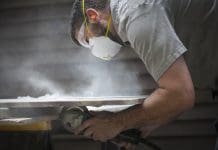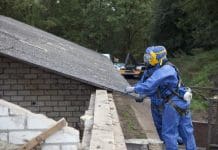Wayne Bagnall MBE, chartered member of the Institution of Occupational Health and Safety (IOSH) specialising in asbestos, takes us back to basics and warns how to spot the hidden killer
Asbestos is the name given to a group of naturally occurring minerals that are contained within rock. These natural resources appear as masses of strong, flexible strands that can be separated into thin threads and woven. Heat or chemicals do not affect asbestos fibres, and they do not conduct electricity. They are tougher than steel and quite resilient.
Being carcinogens, all types of it are hazardous. However, the Rotterdam Convention – a treaty signed by a number of sovereign states to control the importation of hazardous chemicals – does not list chrysotile asbestos on its prior informed consent list. This is certainly a talking point because strong scientific evidence indicates the substance can cause asbestosis, lung cancer and mesothelioma.
The risks arise when the substance is disturbed without the necessary controls in place. When this happens, fibres break into tiny airborne particles that float in the air and stick to clothes etc. These fibres are easily inhaled or swallowed and can cause serious health problems, with the lungs being the main organs at risk. Where the fibres penetrate body tissues, they eventually cause permanent damage to the organs 10 to 50 years after the exposure. Diseases caused by exposure are usually inoperable or have no cure mostly resulting in a premature death.
In the UK, more than 4,000 people die each year as a result of contact with asbestos, and this figure is estimated to keep rising for the next 20 years. A quarter of these deaths result from indirect exposure, with tradesmen such as electricians, joiners, plumbers and demolition trades being at high risk.
It remains in numerous older commercial, industrial and residential buildings in the UK. It can also be found in equipment, vehicles and buried in the ground – particularly where landfill was poorly managed.
The government introduced the duty to manage asbestos provision in all non-domestic buildings in 2004 as part of The Control of Asbestos Regulations 1987 (introduced in 2012). The new provision required duty holders to identify, manage and communicate the extent, condition and locations of their presumed or known containing materials to anyone who is likely to come into contact or disturb it.
In practice, this translates to asbestos surveys and management plans being compiled, managed and communicated. Anyone intending to work invasively or disturb the fabric of the structure on any pre-2000 building must enquire about the presence of asbestos before any work commences.
All employers including the self-employed, have a duty to ensure adequate information, and that instruction and training is provided to anyone who is likely to disturb or be exposed to asbestos. Anyone likely to be working with, or near asbestos, needs to attend an appropriate asbestos training course, which should be delivered by an accredited organisation.
Wayne Bagnall MBE
Chartered Member
Institution of Occupational Health and Safety (IOSH)









![[VIDEO]What to expect when you’re inspecting: Using DorTrak for fire door inspections](https://www.pbctoday.co.uk/news/wp-content/uploads/2025/02/maxresdefault-218x150.jpg)




